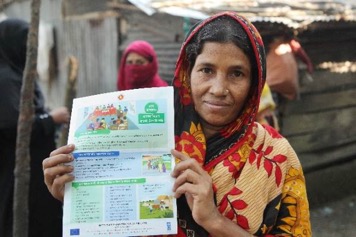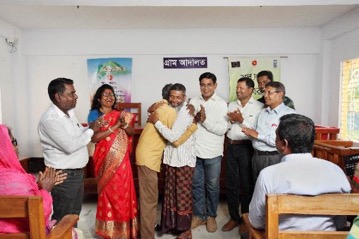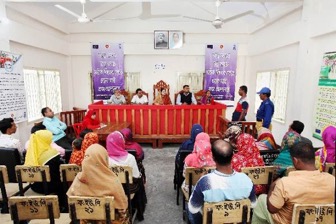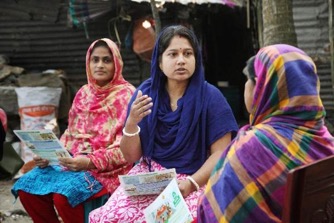 Village Court in Bangladesh: Bridging the Justice Gap
Resolving justice problems that matter to most people - locally, fairly, quickly and at an affordable cost to people and government.
Village Court in Bangladesh: Bridging the Justice Gap
Resolving justice problems that matter to most people - locally, fairly, quickly and at an affordable cost to people and government.

Challenges
Despite years of continued gross domestic product growth (expected to reach 7.2 percent in the 2019/2020 fiscal year) and progress in a range of human and social development indicators, the formal justice sector in Bangladesh continues to suffer from chronic problems at all stages of the justice chain. This significantly impedes access to justice through the courts. The police are understaffed, under-equipped and poorly trained. Court infrastructure is inadequate, and procedures are slow, complex and confusing, which causes cases to be delayed, often by years. According to the Supreme Court of Bangladesh, there is a backlog of 3.5 million cases. Legal aid is limited, and prisons are overcrowded. As a result, people simply do not report minor crimes to the police and prefer to seek support from traditional sources to settle both civil and criminal disputes. They turn to union parishad bodies and the traditional shalish, interventions by village elders or other local elites. In addition, women often face social and economic barriers in seeking justice that actively discourage them from reporting crimes. This makes it more likely that they will be excluded from economic activities in conservative communities as well.
Towards a Solution
To address these challenges, Phase II of the Activating Village Courts in Bangladesh (AVCB II) project has been designed and implemented, with a view to improving justice for disadvantaged and marginalized groups by strengthening village courts in 1,080 union parishads in Bangladesh. The goal of this project is to apply a simple legislative framework to the shalish, so as to formalize a mediated practice that has been part of Bangladeshi culture since time immemorial. This will empower poor local people, especially women, to seek remedies for small injustices that impact their quality of life and will help to restore social harmony to villages (Sustainable Development Goal [SDG] targets 16.3 and 16.b). It will also assist local authorities in being more responsive to local justice needs by providing appropriate legal services in the form of efficient village courts (target 16.6).
The project has been designed using a human rights-based approach to access to justice. Several innovations have been explored in the village court mechanism in the targeted areas, such as the participation of women in justice delivery, capacity development for key stakeholders and behavioural changes for those seeking legal services from the village court.
The cost to the Government for establishing a village court is low, particularly when compared to the social and economic benefits for the communities they serve. Crime appears to be decreasing, as strict actions are taken against every infraction. Cases are diverted away from the criminal justice system, which reduces pressure on the courts and the number of people entering prison. Local administrators see improvements in social harmony. In addition, women, who make up 36 percent of complainants, feel they will get a fair hearing in a safe environment. Complainants obtain a quick and generally positive outcome; in 80 percent of cases, a settlement is agreed upon and compensation is paid.
As of 2020, approximately one quarter of the union parishads (1,078 out of 4,571) have activated village courts, providing an accessible, lawful remedy to 21 million people. The average distance is 3 km, and cases seldom last longer than 28 days or take more than two visits. Monthly incomes remain the same (US$50 to $150), but the cost of cases, between $1 and $2.50, is a fraction of those brought in formal courts. To date, 169,304 cases have been reported, with an average of 5 cases reported per month per union parishad. Of those cases, 138,117, or approximately 80 percent, were resolved through village courts. Of those resolved cases, 130,754 decisions, or approximately 95 percent, have been implemented fully at this time (in line with SDG 16 on peace, justice and strong institutions).
The project has a good possibility of becoming sustainable since it is completely embedded in local government structures, was developed based on the Village Courts Act and is highly relevant to the people it serves, particularly the rural poor. It also impacts those responsible for justice services, including the judiciary, the police, the National Legal Aid Services Organization and civil society organizations. The Government has demonstrated its ownership of the village courts by amending the Village Court Act and disbursing 152.2 million takas ($1.81 million) of national resources to establish village courts in 1,267 union parishads, which exceeds the goal of the project. It has also issued directives to local administrations regarding the management and monitoring of village courts. One of the major challenges to sustainability is the shortage of human resources in the union parishads to administer the village courts once they have phased out of the project. The Government has been addressing this human resources issue and has begun deploying dedicated staff, Assistant Accountant cum Computer Operators, to each union parishad in order to administer village court issues.
Lack of access to justice is a chronic problem for many developing countries. They could learn from the experience of Bangladesh in running village courts and adapt these best practices to local contexts in order to fulfil the justice needs of poor and vulnerable people in rural areas, particularly women. In replicating these best practices, countries must focus on increasing the participation of women in the justice delivery process, promoting ownership in local administrations and developing a mechanism to refer cases from police and formal judiciary systems. In addition, integrated approaches that focus on community mobilization and awareness should also be considered to build trust in the village courts among villagers and promote the use of these services in resolving disputes locally and without hassle. The Bangsamoro Autonomous Region of the Philippines expressed interest in this initiative during a visit to Bangladesh. Successful replication in Bangsamoro could facilitate South-South cooperation.
Contact Information
Countries involved
Supported by
Implementing Entities
Project Status
Project Period
URL of the practice
Primary SDG
Secondary SDGs
Similar Solutions
| NAME OF SOLUTION | Countries | SDG | Project Status | |
|---|---|---|---|---|
360-Degree Awareness Tool to Fight COVID-19 Raising awareness and ensuring public wellbeing through a one-stop platform for fighting COVID-19 in Bangladesh |
Bangladesh | 16 - Peace and Justice Strong Institutions | Ongoing | View Details |
A Billion Brains: Smarter Children, Healthier Economies High Level Meeting on South-South Cooperation for Child Rights |
Bangladesh | 17 - Partnerships for the Goals | Completed | View Details |
A-Card Initiative |
Bangladesh | 10 - Reduced Inequalities | Completed | View Details |
Accelerating Digital Transformation in All Ministries in Bangladesh Promoting the rapid design and implementation of plans to digitize all ministries and subordinate government institutions in Bangladesh |
Bangladesh | 10 - Reduced Inequalities | Ongoing | View Details |
Accelerator Labs Network Following collective intelligence methods to address emerging sustainability challenges and the growing demand for local solutions |
Bangladesh | 08 - Decent Work and Economic Growth 13 - Climate Action | Ongoing | View Details |



